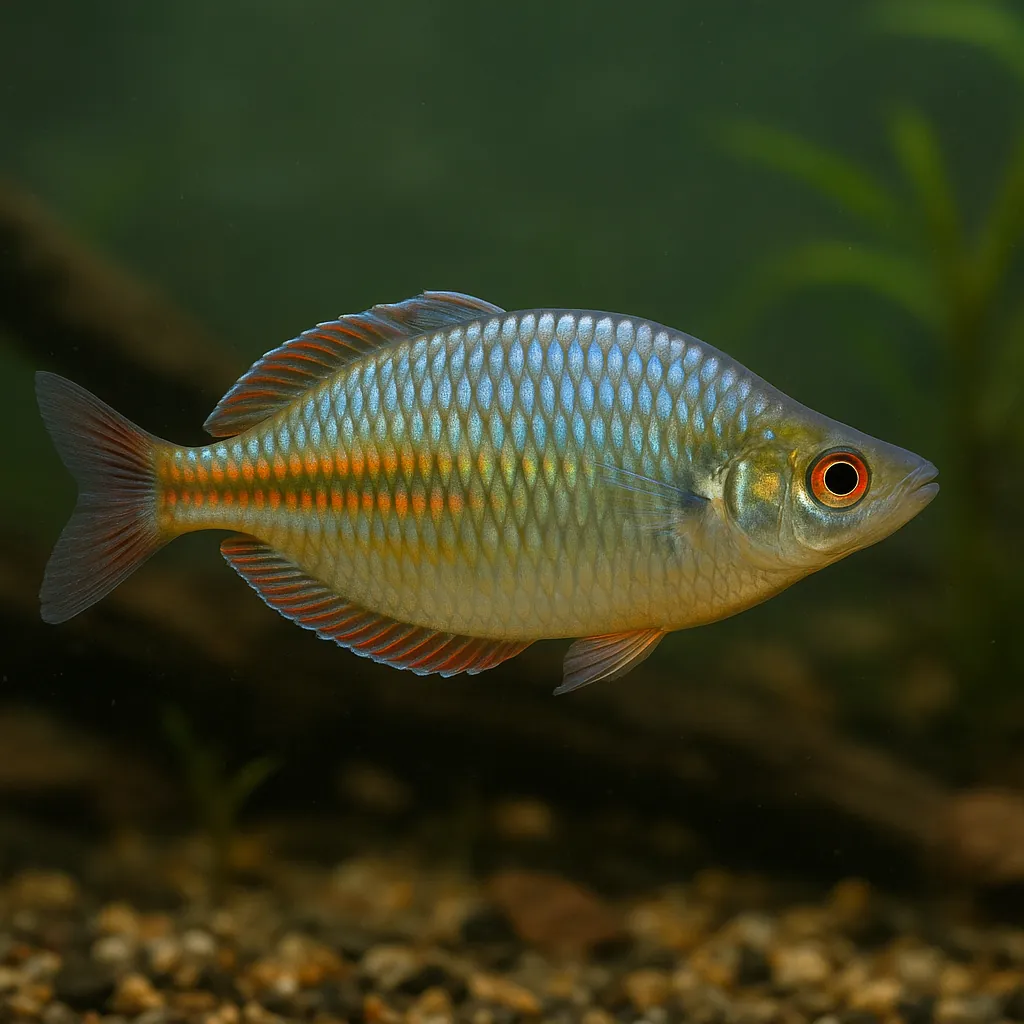
Dwarf rainbowfish
Introduction
The Dwarf Rainbowfish, scientifically known as Melanotaenia praecox, is a vibrant and active species cherished by aquarists for its iridescent blue body and striking red or yellow fins. Despite their small size, these fish bring a dynamic presence to freshwater aquariums. They are relatively hardy and adaptable, making them suitable for both beginner and intermediate fishkeepers seeking to add a splash of color and energy to their tanks.
What makes the Dwarf Rainbowfish a popular choice among aquarists?
Their dazzling coloration, lively behavior, and compatibility with various tank mates make them a standout addition to community aquariums.
Are Dwarf Rainbowfish suitable for beginners?
Yes, their hardy nature and straightforward care requirements make them an excellent choice for novice fishkeepers.
Care and Environment
Providing optimal care for Dwarf Rainbowfish involves attention to tank size, water parameters, diet, and tank setup to ensure their health and vibrant appearance.
What is the minimum tank size for Dwarf Rainbowfish?
A minimum tank size of 60 liters (15 gallons) is recommended to accommodate their active swimming behavior. However, a larger tank of at least 75 liters (20 gallons) is ideal for a group, allowing ample space for schooling and reducing stress.
What are the ideal water parameters for Dwarf Rainbowfish?
They thrive in temperatures between 22–28°C (72–82°F), with a pH range of 6.0 to 8.0, and prefer soft to moderately hard water. Maintaining stable water conditions is crucial, as they are sensitive to fluctuations.
How should the tank be set up for Dwarf Rainbowfish?
A well-planted aquarium with open swimming areas is ideal. Incorporate both live and floating plants to mimic their natural habitat and provide hiding spots. Ensure the tank has gentle filtration and moderate water flow to replicate the slow-moving streams they originate from.
What should be included in their diet?
As omnivores, Dwarf Rainbowfish require a varied diet. High-quality flake or pellet foods should be supplemented with live or frozen foods like brine shrimp, daphnia, and bloodworms. Including vegetable matter, such as blanched spinach or spirulina flakes, ensures balanced nutrition.
Are there any specific challenges in keeping Dwarf Rainbowfish?
While generally hardy, they are sensitive to poor water quality and low oxygen levels. Regular water changes and proper filtration are essential. Additionally, males may display aggression during breeding, so maintaining a balanced male-to-female ratio and providing ample space can mitigate this behavior.
Origin and Habitat
Dwarf Rainbowfish are native to the slow-moving tributaries and streams of New Guinea's rainforests. These environments are characterized by dense vegetation, soft, slightly acidic to neutral water, and gentle currents. The natural habitat's rich plant life provides ample hiding spots and breeding grounds, which can be replicated in the home aquarium to promote their well-being.
Where are Dwarf Rainbowfish originally from?
They originate from the rainforest streams and tributaries of New Guinea.
What type of environment do they inhabit in the wild?
They thrive in slow-moving, densely vegetated waters with soft, slightly acidic to neutral conditions.
Temperament and Compatibility
Dwarf Rainbowfish are peaceful, schooling fish that exhibit lively and social behavior. They are best kept in groups of at least six to encourage natural schooling behavior and reduce stress. Males may display mild aggression during breeding, but this is typically non-harmful and can be managed by maintaining a balanced male-to-female ratio.
Are Dwarf Rainbowfish aggressive?
Generally, they are peaceful, but males may show mild aggression during breeding periods.
What are suitable tank mates for Dwarf Rainbowfish?
They coexist well with other peaceful, similarly sized fish such as tetras, rasboras, danios, and small catfish. Avoid housing them with larger or aggressive species that may intimidate or prey on them.
How can I create a harmonious community tank with Dwarf Rainbowfish?
Ensure the tank is spacious enough to accommodate all species comfortably, maintain stable water conditions, and provide plenty of hiding spots and visual barriers to reduce potential stress and aggression.
Interesting Facts
Dwarf Rainbowfish are known for their iridescent scales that can change intensity based on lighting and mood, adding a dynamic visual element to aquariums. Males often display their brightest colors and a distinctive shiny stripe on their heads during courtship displays to attract females.
Can Dwarf Rainbowfish change color?
Yes, their iridescent scales can appear more vibrant depending on their mood and the lighting conditions.
How do males attract females during breeding?
Males exhibit their brightest colors and may develop a shiny stripe on their heads to attract females during courtship displays.
Are Dwarf Rainbowfish easy to breed in captivity?
Yes, they are egg scatterers and can breed readily in well-maintained aquariums, especially when provided with fine-leaved plants or spawning mops for egg deposition.
Sources
All information in this article has been gathered from the following reputable sources:
Overview
Recommended Tank Size 19.8 Gallons (for groups of 6 or more) |
Minimum Group Size 6 |
Maximum Adult Size |
Minimum Tank Volume 15.9 Gallons |
Maximum Adult Length 3.1 inches |
Average Adult Length 2.8 inches |
Shoaling (6+ required) Yes |
Preferred Water Type Freshwater, soft to moderately hard, slightly acidic to neutral |
Temperature Range (°C) 22–28 |
pH Range 6.0–8.0 |
Water Hardness (dGH) 5–20 |
Typical Lifespan (years) 3 years |